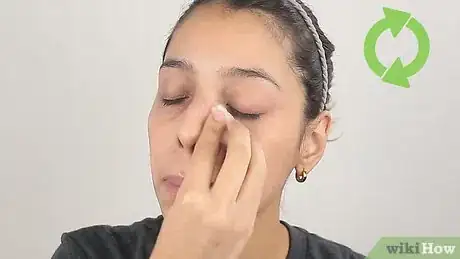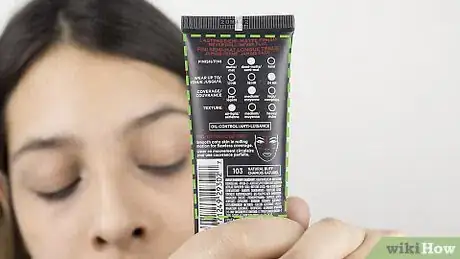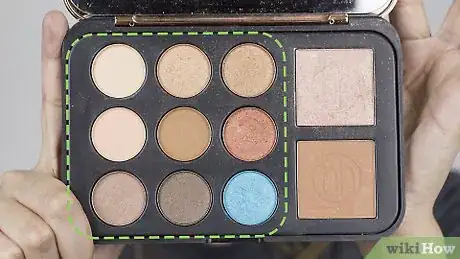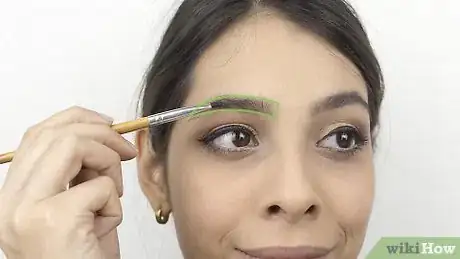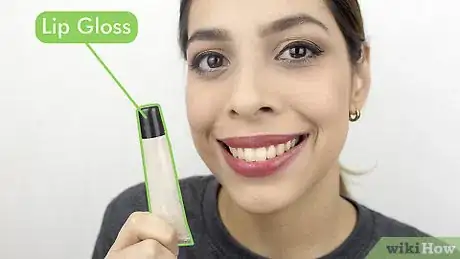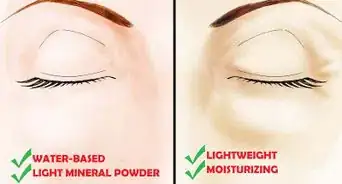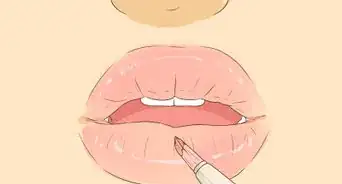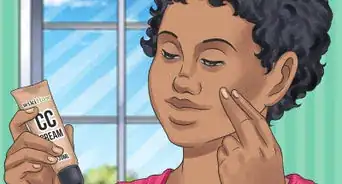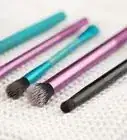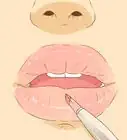This article was co-authored by Daniel Vann. Daniel Vann is the Creative Director for Daredevil Cosmetics, a makeup studio in the Seattle Area. He has been working in the cosmetics industry for over 15 years and is currently a licensed aesthetician and makeup educator.
There are 9 references cited in this article, which can be found at the bottom of the page.
wikiHow marks an article as reader-approved once it receives enough positive feedback. In this case, 100% of readers who voted found the article helpful, earning it our reader-approved status.
This article has been viewed 471,703 times.
Why does it feel like every makeup tutorial on the web covers super wacky, complicated styles? If you're excited to get into the world of makeup but you want to start simple, don't stress; it's so much easier to master a basic look than you'd think! With a little help, you'll be ready to do your own makeup in no time. We're going to cover everything you need to know. To learn how to apply basic makeup, read on!
Steps
Applying Foundation and Powder
-
1Start with a clean face. Wash your face with a gentle cleanser and pat it dry.[1] You can also use a cleanser with exfoliating micro-beads or buff your skin with an exfoliating face pad.
- Try wiping your face with a cotton ball soaked in toner. This will help tighten your pores.
- Pat your face dry with a clean towel.
- If you use a cleanser with an exfoliator, you should rinse your face before patting it dry with a towel.
-
2Apply some moisturizer. Chose a moisturizer that is appropriate for your skin type and apply it to your face.[2] Gently dot it along your nose, cheekbones, and forehead, and blend it in using circular motions.[3]
- If you dislike wearing too much on your face, you can purchase a tinted moisturizer that matches your skin tone. This way, you won't have to apply primer or foundation.
- To determine which moisturizer is right for a certain skin tone, check the labels for products specific to your issue (oily skin, dry skin, sensitive skin, etc.).
Advertisement -
3Consider applying some primer. While applying face primer is not necessary, it can help you achieve that smooth, air-brushed finish by filling in any gaping pores. Most primers also act as a binding solution to help makeup stay on your skin longer. You can use a basic face primer, or you can use one with special qualities, such as a matte finish or a redness reducer. You can purchase them in a beauty shop or boutique.EXPERT TIPNini Efia Yang is the Owner of Nini's Epiphany, a San Francisco Bay Area makeup and hair studio. Specializing in bridal makeup with almost 10 years of experience, her work has been featured in Ceremony Magazine, They So Loved, and Wedding Window.Makeup Artist

 Nini Efia Yang
Nini Efia Yang
Makeup ArtistOur Expert Agrees: Primer creates a smooth texture for your foundation. If you choose a primer that's formulated for your skin type, it can also help your foundation last longer.
-
4Consider applying some concealer. Concealer is great for hiding discolorations, blemishes, and those dreaded under-eye circles.[4] Choose a concealer that is the same color as your foundation, but one or two shades lighter. Gently apply the concealer over the blemish, discoloration, or under-eye circle using a tapping motion. You can use your finger, a makeup sponge, or even a small brush. There are different types of concealer, the under-eye area needs a thinner formula than what you would cover blemishes in other areas with, or it will crack. Be sure to blend the edges of the concealer into your skin.[5] To make sure concealer doesn't crack or wrinkle, quickly pat some powder over the concealer, powders that are translucent or your skin tone blend best. You can also use a color-correcting concealer to cover up some problem areas. Here are some tips:[6]
- If you have red areas or pimples, use green concealer. The green will conceal out the redness.
- If you have dark circles under your eyes, use orange or yellow-tinted concealer.
- If you have a yellowish skin tone, use some lilac-tinted concealer. The lilac pigment will help cancel out the yellow.
-
5Choose a foundation color that matches your skin tone. You can do this by placing a small amount along your jaw. Some companies sell foundations for cool, neutral, and warm undertones. If you are purchasing a foundation from such a company, make sure that you purchase the right skin tone and undertone. Getting foundation in the wrong skin tone and undertone can make your face look orangey, yellowish, or ashy. Yikes! Here are some quick tips for determining your skin undertone:[7]
- If your veins look purple or blue, you have a cool undertone. If your veins look green, you have a warm undertone. If you cannot tell, you most likely have a neutral undertone.
- If you look best in cool colors, such as bright greens, blues, and purples, you have a cool undertone. If you look best in warmer colors, such as reds, oranges, yellows, and olive-greens, then you have a warm undertone. If you look good in all colors, then you have a neutral undertone.
- If you look best in silver jewelry, you have a cool undertone. If you look best in gold jewelry, you have a warm undertone. If you look good in both gold and silver, then you have a neutral undertone.
-
6Decide how much coverage you want. When selecting your foundation, it is also important to decide how much coverage you want. There are different types of foundations available, and each will give you different results. Here are some tips:
- Cream foundation is thick, but it will give you the most coverage. You may not even need concealer for this foundation. It can feel heavy on your face, however. This type of foundation is suitable for normal and dry skin types.
- Liquid foundation can give you a sheer coverage to a medium coverage. It will look more natural the sheerer it is, and will help even out your skin tone. Some blemishes may still show through, however, and you may need to use concealer. This type of foundation is suitable for dry and combination skin types.
- Powder foundation will give you the lightest coverage, and will look the most natural. It is the best for evening out your skin tone and giving you the no-makeup look. This type of foundation is suitable for oily skin types.
-
7Apply your foundation. There are many different ways you can apply your foundation. Coverage also depends on what you use to put the foundation on your skin. Generally beauty blenders give the most coverage, then foundation brushes, and then fingers or sponges. You can use your fingers, a makeup sponge, or even a foundation brush, depending on the type of foundation you have.[8] Start applying your foundation to your nose, and work your way outward along your chin, cheeks, and nose bridge. Blend the foundation outward, and be sure to get your jaw line, sides of face, forehead, and neck.[9]
- If you are using powder foundation, you can apply the makeup using a makeup sponge or a powder brush.
- If you are using liquid foundation, you can use a makeup sponge, a makeup brush, or your fingers. If you choose to use a makeup sponge, consider dampening it in water first. This will prevent the sponge from soaking up too much foundation, and thus wasting it.
- If you are using cream foundation, you can use a makeup sponge, a makeup brush, or your fingers.
-
8Dust lightly with powder. Choose a powder that matches your skin tone and swirl your powder brush in it. Lightly tap or blow the excess powder off, then brush it onto your face.[10] Focus on the nose, forehead, and cheekbones. The powder will help set the foundation and reduce shine. It will also further smooth your face in preparation for other powder makeup, such as blush and eye shadow. Be sure to dust any excess powder off your face.
Applying Makeup to Your Eyes
-
1Choose your eye shadow colors. You will need three different shades: a medium shade for the lid, a dark shade for the crease, and a light shade for the base and highlight. Try to choose colors from the same color family, such as all blues or all browns. Also, keep in mind that different colors may enhance different eye colors. Here are some suggestions:[11]
- For the best blending, eye shadow should have four different shades: The lightest (a shade close to white) on the inner corner and just under your browbone, the second lightest over the lid, next darkest on the crease, and darkest on the outer corner blended in.
- If you have blue eyes, you can wear similar shades, such as dark blue, grey, and silver. You can also wear contrasting shades, such as bronze, brown, copper, and taupe.[12]
- If you have brown eyes... you can wear similar shades, such as bronze, brown, and taupe. You can also wear contrasting shades, such as blue, green, grey, and purple.
- If you have green eyes, you can wear similar shades, such as green, and forest green. You can also wear contrasting shades, such as gold, pink, taupe, and purple.
- If you have grey eyes you can wear similar shades, such as blue, charcoal, and silver. You can also wear contrasting shades, such as brown, gold, green, and purple.
- If you have hazel eyes, you can use greens and golds to bring out the greens and golds in your own eyes. You can also use contrasting colors, such as plum, reddish-brown, and wine.
-
2To make your eye makeup brighter and longer-lasting, apply an eyeshadow primer before any shadow. Or simply use a dot of liquid concealer in place of primer.
-
3Apply the base and highlight. Choose your lightest shade. Swirl your brush in the eye shadow and sweep it over your entire eyelid, from the lash line all the way up to the eyebrow. Gently blend the shadow towards the corner or you eye and away from your eye. You can leave your eye shadow like this, or add extra definition by adding some shadow and lid color.
- Consider brushing some loose powder under your eye, just beneath the eyelashes. This will catch any loose specks of eye shadow. When you are done applying your eye shadow, you can brush this powder off using a clean brush.
- Some people do not like having the same highlight color as their base. If this applies to you, you can use an eye shadow primer to stop your eye shadow from creasing. Be sure to apply your highlight in your inner corners to open up your eyes and to your brow bone to give your eyes definition.
-
4Apply the lid color. Swish you brush across the medium shade and sweep it along the entire eyelid, going from right next to inner corner of your eye to the outer corner.
-
5Apply the crease color. Take a smaller brush and sweep it across the darkest shade. Run it along the crease of your eye, going in an arch starting from the outer corner and following the shape of your natural eye socket, or where your eyelids fold in when you open your eyes.
-
6Blend your eye shadow. Using a small, fluffy brush, go over the eyelid, where the lid meets the crease. Next, go over the brow, where the crease meets the brow. When you blend, run your brush from the inner corner of your eye to the outer and back to the inner in a rainbow motion.
- If you brushed loose powder beneath your eye, you can dust it off after you have finished blending everything.
-
7Apply the eyeliner. Place the tip of your eyeliner as close as possible to the lash line on your upper lid. Slowly draw a smooth line, going from the middle of your eyelid to the outer corner. Then, going from the middle to the inner corner. You can extend the eyeliner a little bit beyond the outer corner, creating a wing tip. Whether you use eyeliner pencil or liquid eyeliner depends entirely on what is easiest for you to work with. Here are some more tips on applying eye liner:
- For a natural, daytime look, use brown or black-brown liner. For a more defined or evening look, use black eyeliner.
- It helps if you hold a pocket mirror in your other hand, and look down at the mirror while applying the eyeliner.
- You can also close your eye partway, and gently pull on the outer corner of your eye, stretching the lid. Draw your eyeliner in a neat line.
- You can use eyeliner or eye shadow on your bottom lid. Eyeliner will give you a more defined look, while a thin line of charcoal or dark brown eye shadow will give you a softer look.
-
8Apply the mascara. Start applying your mascara from the middle of your eye. Dip the brush into the container and pull it out, dragging it along the rim of the container to remove any excess mascara. Bring the brush as close as possible to your lash line and gently pull it up, wiggling it from side to side slightly; lower your eyelids at the same time as you are pulling the brush up. Repeat the process for the outer and inner corners of your eye.
- You can apply some mascara to your bottom lashes. Simply bring the brush as close as possible to the lower lash line, and brush downward.
-
9Consider shading in your eyebrows. Unless you have very thick eyebrows, you might want to fill them in. You can use eyebrow pencil or eye shadow. Follow the natural curve of you eyebrow, making the color softer and lighter the closer it gets to your nose. In general, you want to use a color that is two to three shades lighter than your hair color, unless you have blonde hair. Then, go 2-3 shades darker. Here are some more tips:
- If you have blond or light colored hair, use a light brown or medium brown.
- For brown hair or medium-colored hair, use a medium or dark brown.
- If you have black hair, use a very dark brown. Never use black, as it will be too harsh.
- If you have red hair, use a color close to your hair color, but two to three shades darker.
- For other, unusual hair colors, such as blue, green, pink, or purple, consider using a shadow that matches your hair color, and going two to three shades darker. You can play around with colors, or use a color that matches your original eyebrow color.
EXPERT TIPYour brows really frame your face, so if you have thin brows, it's a good idea to fill them in a little.
Nini Efia Yang is the Owner of Nini's Epiphany, a San Francisco Bay Area makeup and hair studio. Specializing in bridal makeup with almost 10 years of experience, her work has been featured in Ceremony Magazine, They So Loved, and Wedding Window.
Nini Efia Yang
Makeup Artist Nini Efia Yang
Nini Efia Yang
Makeup Artist
Applying Makeup to your Lips and Cheeks
-
1Apply the blush. Choose a color that suits you, and apply it along or just barely on top of your cheekbones.[13] How you apply your blush will depend on the type of blush you bought: cream or powder. If you are using a powder blush, then you can apply it with a powder brush. If you are using a cream blush, then lightly dab it onto your cheeks with your fingers, and then softly blend it outwards. Do not apply too much blush, however; you want just enough blush to give you a healthy glow. Here are some guidelines for finding the right shade of blush:[14]
- If you have light skin, go for soft pinks, light corals, and peaches.
- If you have medium skin, go for rich pinks, warm mauves, and deep peaches.
- If you have dark skin, go for deep fuchsias, warm browns, and tangerines.
-
2Consider adding some bronzer. For a healthy, sun-kissed look, you can apply some bronzer.[15]
- Bronzer usually doesn't go on the nose, unless you're contouring, and then it's in very specific areas of the nose.
- Generally bronzer can go all over the face, but defines the face more when applied along jawline, under blush, and along the top of the forehead.
-
3Outline your lips with lip liner. Choose a color that matches your lipstick color. If you wish to have fuller lips, then make the line just outside your natural lip line. If you want to make your lips appear less full, then draw just inside the lip line.
-
4Fill your lips in with lipstick. You can run the lipstick directly over your lips, or you can use a lipstick brush. If you are using a lip brush, simply sweep it across the lipstick, and then run it over your lip. Be sure to stay within your lip lines. Once you have finished applying your lipstick, you can get rid of the excess by pressing your lips down on a piece of folded tissue.
- If you have really dry lips, then put some chap stick or lip balm before you put on your lipstick. This will help soften your lips and prevent too many creases.[16]
- You can make your lipstick last longer by placing a tissue over your lips, and then dusting translucent powder over the tissue. Just enough powder will seep through the tissue to seal the lipstick in.
- For extra glimmer, apply a coat of lip gloss.
-
5Consider using lip gloss instead of lip liner and lipstick. If you are going for a neutral, natural look, you can omit the lip liner and lipstick, and brush on a coat of lip gloss instead. Lip gloss works well for the day time, because it is soft and light; lipstick works best for evenings.
Expert Q&A
Did you know you can get expert answers for this article?
Unlock expert answers by supporting wikiHow
-
QuestionWhere do I start with eye makeup?
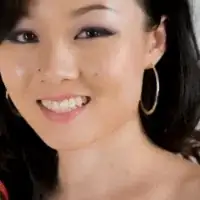 Nini Efia YangNini Efia Yang is the Owner of Nini's Epiphany, a San Francisco Bay Area makeup and hair studio. Specializing in bridal makeup with almost 10 years of experience, her work has been featured in Ceremony Magazine, They So Loved, and Wedding Window.
Nini Efia YangNini Efia Yang is the Owner of Nini's Epiphany, a San Francisco Bay Area makeup and hair studio. Specializing in bridal makeup with almost 10 years of experience, her work has been featured in Ceremony Magazine, They So Loved, and Wedding Window.
Makeup Artist
-
QuestionHow do you hire an affordable makeup artist for a wedding?
 Kelly ChuKelly is the lead makeup artist and educator of the Soyi Makeup and Hair team that is based in the San Francisco Bay Area. Soyi Makeup and Hair specializes in wedding and event makeup and hair. Over the past 5 years, the team has created bridal looks for over 800 brides in America, Asia, and Europe.
Kelly ChuKelly is the lead makeup artist and educator of the Soyi Makeup and Hair team that is based in the San Francisco Bay Area. Soyi Makeup and Hair specializes in wedding and event makeup and hair. Over the past 5 years, the team has created bridal looks for over 800 brides in America, Asia, and Europe.
Professional Makeup Artist
-
QuestionHow should you fix your makeup after you have slept in it?
 Kelly ChuKelly is the lead makeup artist and educator of the Soyi Makeup and Hair team that is based in the San Francisco Bay Area. Soyi Makeup and Hair specializes in wedding and event makeup and hair. Over the past 5 years, the team has created bridal looks for over 800 brides in America, Asia, and Europe.
Kelly ChuKelly is the lead makeup artist and educator of the Soyi Makeup and Hair team that is based in the San Francisco Bay Area. Soyi Makeup and Hair specializes in wedding and event makeup and hair. Over the past 5 years, the team has created bridal looks for over 800 brides in America, Asia, and Europe.
Professional Makeup Artist Blot the excess facial oil with a piece of tissue using a dapping motion. Apply a thin layer of moisturizer to the dry area that looks flaky. Load some foundation on a q-tip and use it to remove the smudged eyeliner. Remove all of the lipstick with a tissue or cotton pad. Apply some liquid foundation to the edge of the lips and a thin layer of concealer to the under-eye area and blend it. Dust a thin layer of setting powder. If needed, reapply some blush, eyeshadow, and eyeliner. Then reapply the lipstick.
Blot the excess facial oil with a piece of tissue using a dapping motion. Apply a thin layer of moisturizer to the dry area that looks flaky. Load some foundation on a q-tip and use it to remove the smudged eyeliner. Remove all of the lipstick with a tissue or cotton pad. Apply some liquid foundation to the edge of the lips and a thin layer of concealer to the under-eye area and blend it. Dust a thin layer of setting powder. If needed, reapply some blush, eyeshadow, and eyeliner. Then reapply the lipstick.
wikiHow Video: How to Apply Basic Makeup
Warnings
- Do not go to sleep in your makeup. Not only will you wake up to a messy, makeup-smeared face, but you will also clog your pores up. This will lead to breakouts. Always clean your face before going to sleep.⧼thumbs_response⧽
- Some people can be allergic to the ingredients in makeup. If you develop any allergies, stop using your makeup immediately, and consider using organic or mineral-based makeup instead.⧼thumbs_response⧽
Things You'll Need
- Moisturizer (optional but recommended)
- Foundation and powder
- Eye shadow
- Eye liner and mascara
- Blush
- Lip liner and lipstick
- Makeup brushes, makeup sponges, and powder brushes
References
- ↑ Kelly Chu. Professional Makeup Artist. Expert Interview. 9 May 2019.
- ↑ Kelly Chu. Professional Makeup Artist. Expert Interview. 9 May 2019.
- ↑ Daniel Vann. Licensed Aesthetician. Expert Interview. 12 April 2019.
- ↑ Daniel Vann. Licensed Aesthetician. Expert Interview. 12 April 2019.
- ↑ Prevention, The Best Way to Apply Concealer
- ↑ Paula's Choice, How to Choose and Use Concealer
- ↑ Bustle, Warm Or Cool Skin Tone: 5 Questions To Help You Determine Your Undertones
- ↑ Kelly Chu. Professional Makeup Artist. Expert Interview. 9 May 2019.
- ↑ Makeup.com, How to Apply Foundation
- ↑ Daniel Vann. Licensed Aesthetician. Expert Interview. 12 April 2019.
- ↑ My Thirty Spot, Opposites Attract – Matching Your Eyeshadow to Your Eye Color to Make Them Pop!
- ↑ Kelly Chu. Professional Makeup Artist. Expert Interview. 9 May 2019.
- ↑ Daniel Vann. Licensed Aesthetician. Expert Interview. 12 April 2019.
- ↑ Makeup.com, How to Find the Right Blush for Your Skin Tone
- ↑ Daniel Vann. Licensed Aesthetician. Expert Interview. 12 April 2019.
- ↑ Daniel Vann. Licensed Aesthetician. Expert Interview. 12 April 2019.
- Videos provided by Jennifer Chiu
About This Article
To apply basic makeup, start by washing your face with a gentle cleanser and patting it dry with a clean towel. Then, apply moisturizer by dotting it along your nose, cheekbones, forehead, and chin. Gently massage the moisturizer into your skin with your fingertips using circular motions. To even out the texture of your skin and help your foundation stay on better, consider smoothing on a primer over your moisturizer. Next, grab a concealer that’s 1 or 2 shades lighter than your foundation and dab it onto any areas where you see redness, blemishes, or discoloration. To blend the concealer, tap it into your skin with your fingertips, a makeup sponge, or a small brush. Cover the concealer with a small amount of translucent powder to prevent it from cracking or wrinkling. Now it’s time to apply your foundation. Use a foundation that matches your natural skin tone as closely as possible. Depending on how much coverage you want, choose a creamy full-coverage foundation, a lighter liquid foundation, or a sheer, natural-looking powder. Apply the foundation with a makeup sponge, brush, or your fingertips, starting at the middle of your face and blending outward. When you’re done, swirl a makeup brush in a powder that matches your skin tone and lightly brush it over your face to set your foundation and reduce shine. Next, tap some eyeshadow primer or a dot of liquid concealer onto each eyelid to help prevent your eye makeup from creasing or rubbing off. Select a base eyeshadow color and brush it over your entire eyelid, from the lash line up to your eyebrow. Use a blender brush to blend the shadow toward the inner corner of your eye and away from your eye at the outer edge. Then, take a smaller brush and blend a third, darker color into the crease at the top of your eyelid. Using this same color, create an arch connecting the crease of your eye to the outer corner to help define your lid. Blend all the eyeshadow colors together by gently buffing your lid with a small, fluffy brush, paying special attention to the crease and the corners of your eyes. Dust off any loose eyeshadow under your eye with a small brush when you’re done. Grab a mascara wand and swipe it along your upper lashes from beneath, starting as close to the lash line as possible and working your way to the tips. Start with the lashes in the middle and work your way out to the edges. Finish up by filling in your eyebrows with an eyebrow pencil, using small, hairlike strokes that follow the natural curve of your brows. To finish your makeup look, sweep a little blush along the tops of your cheekbones with a brush. Or, if you’re using a cream blush, gently tap it in with your fingers. For a sun-kissed look, dust some bronzer along your jawline, the top of your forehead, and your cheekbones. Next, apply a lipliner that matches the color of your lipstick along the natural outlines of your lips. Then, fill in your lips with lipstick, being careful to stay within the lines that you drew. To learn how to complement your eye and skin color with the right eye shadow shades, keep reading!
